Kun Wei
DAIEN-TTS: Disentangled Audio Infilling for Environment-Aware Text-to-Speech Synthesis
Sep 18, 2025Abstract:This paper presents DAIEN-TTS, a zero-shot text-to-speech (TTS) framework that enables ENvironment-aware synthesis through Disentangled Audio Infilling. By leveraging separate speaker and environment prompts, DAIEN-TTS allows independent control over the timbre and the background environment of the synthesized speech. Built upon F5-TTS, the proposed DAIEN-TTS first incorporates a pretrained speech-environment separation (SES) module to disentangle the environmental speech into mel-spectrograms of clean speech and environment audio. Two random span masks of varying lengths are then applied to both mel-spectrograms, which, together with the text embedding, serve as conditions for infilling the masked environmental mel-spectrogram, enabling the simultaneous continuation of personalized speech and time-varying environmental audio. To further enhance controllability during inference, we adopt dual class-free guidance (DCFG) for the speech and environment components and introduce a signal-to-noise ratio (SNR) adaptation strategy to align the synthesized speech with the environment prompt. Experimental results demonstrate that DAIEN-TTS generates environmental personalized speech with high naturalness, strong speaker similarity, and high environmental fidelity.
Efficient Scaling for LLM-based ASR
Aug 06, 2025Abstract:Large language model (LLM)-based automatic speech recognition (ASR) achieves strong performance but often incurs high computational costs. This work investigates how to obtain the best LLM-ASR performance efficiently. Through comprehensive and controlled experiments, we find that pretraining the speech encoder before integrating it with the LLM leads to significantly better scaling efficiency than the standard practice of joint post-training of LLM-ASR. Based on this insight, we propose a new multi-stage LLM-ASR training strategy, EFIN: Encoder First Integration. Among all training strategies evaluated, EFIN consistently delivers better performance (relative to 21.1% CERR) with significantly lower computation budgets (49.9% FLOPs). Furthermore, we derive a scaling law that approximates ASR error rates as a computation function, providing practical guidance for LLM-ASR scaling.
HDMoLE: Mixture of LoRA Experts with Hierarchical Routing and Dynamic Thresholds for Fine-Tuning LLM-based ASR Models
Sep 30, 2024



Abstract:Recent advancements in integrating Large Language Models (LLM) with automatic speech recognition (ASR) have performed remarkably in general domains. While supervised fine-tuning (SFT) of all model parameters is often employed to adapt pre-trained LLM-based ASR models to specific domains, it imposes high computational costs and notably reduces their performance in general domains. In this paper, we propose a novel parameter-efficient multi-domain fine-tuning method for adapting pre-trained LLM-based ASR models to multi-accent domains without catastrophic forgetting named \textit{HDMoLE}, which leverages hierarchical routing and dynamic thresholds based on combining low-rank adaptation (LoRA) with the mixer of experts (MoE) and can be generalized to any linear layer. Hierarchical routing establishes a clear correspondence between LoRA experts and accent domains, improving cross-domain collaboration among the LoRA experts. Unlike the static Top-K strategy for activating LoRA experts, dynamic thresholds can adaptively activate varying numbers of LoRA experts at each MoE layer. Experiments on the multi-accent and standard Mandarin datasets demonstrate the efficacy of HDMoLE. Applying HDMoLE to an LLM-based ASR model projector module achieves similar performance to full fine-tuning in the target multi-accent domains while using only 9.6% of the trainable parameters required for full fine-tuning and minimal degradation in the source general domain.
Ideal-LLM: Integrating Dual Encoders and Language-Adapted LLM for Multilingual Speech-to-Text
Sep 17, 2024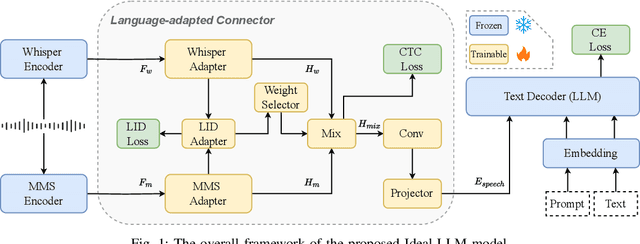
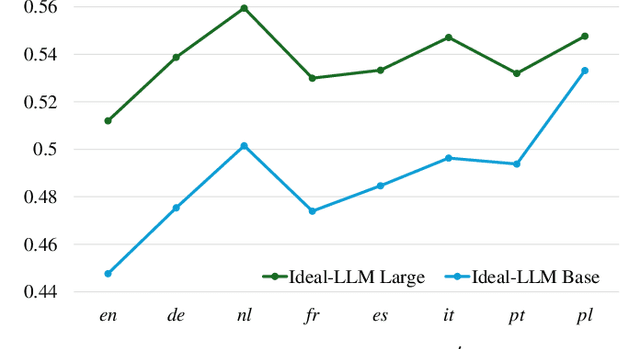
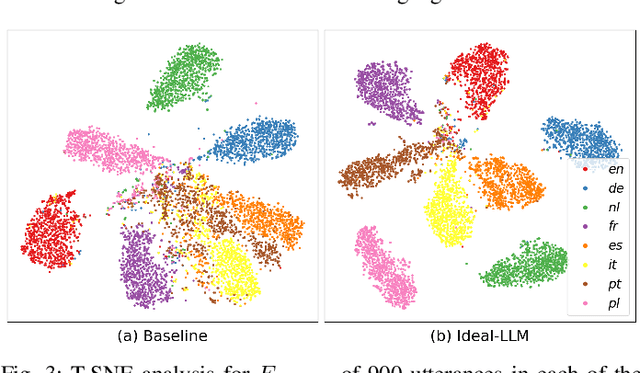

Abstract:Integrating audio encoders with LLMs through connectors has enabled these models to process and comprehend audio modalities, significantly enhancing speech-to-text tasks, including automatic speech recognition (ASR) and automatic speech translation (AST). However, these methods often overlook the critical aspect of language adaptation in multilingual settings, relying instead on multilingual data without adequately addressing language differences. To address this gap, we propose the Ideal-LLM model, which employs dual multilingual encoders to enrich language feature information and utilizes a language-adapted connector to target the adaptation of each language specifically. By leveraging the complementary strengths of Whisper and MMS encoders, our approach ensures richer multilingual representations. Additionally, the language-adapted connector enhances modal transformation via a language weight selector tailored for each language. Experimental results demonstrate that Ideal-LLM significantly improves ASR performance, achieving a 32.6% relative reduction in average word error rates compared to the standard speech encoder integrated with LLMs and yields an average BLEU score of 36.78 for AST task.
Advancing Multi-talker ASR Performance with Large Language Models
Aug 30, 2024



Abstract:Recognizing overlapping speech from multiple speakers in conversational scenarios is one of the most challenging problem for automatic speech recognition (ASR). Serialized output training (SOT) is a classic method to address multi-talker ASR, with the idea of concatenating transcriptions from multiple speakers according to the emission times of their speech for training. However, SOT-style transcriptions, derived from concatenating multiple related utterances in a conversation, depend significantly on modeling long contexts. Therefore, compared to traditional methods that primarily emphasize encoder performance in attention-based encoder-decoder (AED) architectures, a novel approach utilizing large language models (LLMs) that leverages the capabilities of pre-trained decoders may be better suited for such complex and challenging scenarios. In this paper, we propose an LLM-based SOT approach for multi-talker ASR, leveraging pre-trained speech encoder and LLM, fine-tuning them on multi-talker dataset using appropriate strategies. Experimental results demonstrate that our approach surpasses traditional AED-based methods on the simulated dataset LibriMix and achieves state-of-the-art performance on the evaluation set of the real-world dataset AMI, outperforming the AED model trained with 1000 times more supervised data in previous works.
Unveiling the Potential of LLM-Based ASR on Chinese Open-Source Datasets
May 06, 2024



Abstract:Large Language Models (LLMs) have demonstrated unparalleled effectiveness in various NLP tasks, and integrating LLMs with automatic speech recognition (ASR) is becoming a mainstream paradigm. Building upon this momentum, our research delves into an in-depth examination of this paradigm on a large open-source Chinese dataset. Specifically, our research aims to evaluate the impact of various configurations of speech encoders, LLMs, and projector modules in the context of the speech foundation encoder-LLM ASR paradigm. Furthermore, we introduce a three-stage training approach, expressly developed to enhance the model's ability to align auditory and textual information. The implementation of this approach, alongside the strategic integration of ASR components, enabled us to achieve the SOTA performance on the AISHELL-1, Test_Net, and Test_Meeting test sets. Our analysis presents an empirical foundation for future research in LLM-based ASR systems and offers insights into optimizing performance using Chinese datasets. We will publicly release all scripts used for data preparation, training, inference, and scoring, as well as pre-trained models and training logs to promote reproducible research.
MMGER: Multi-modal and Multi-granularity Generative Error Correction with LLM for Joint Accent and Speech Recognition
May 06, 2024



Abstract:Despite notable advancements in automatic speech recognition (ASR), performance tends to degrade when faced with adverse conditions. Generative error correction (GER) leverages the exceptional text comprehension capabilities of large language models (LLM), delivering impressive performance in ASR error correction, where N-best hypotheses provide valuable information for transcription prediction. However, GER encounters challenges such as fixed N-best hypotheses, insufficient utilization of acoustic information, and limited specificity to multi-accent scenarios. In this paper, we explore the application of GER in multi-accent scenarios. Accents represent deviations from standard pronunciation norms, and the multi-task learning framework for simultaneous ASR and accent recognition (AR) has effectively addressed the multi-accent scenarios, making it a prominent solution. In this work, we propose a unified ASR-AR GER model, named MMGER, leveraging multi-modal correction, and multi-granularity correction. Multi-task ASR-AR learning is employed to provide dynamic 1-best hypotheses and accent embeddings. Multi-modal correction accomplishes fine-grained frame-level correction by force-aligning the acoustic features of speech with the corresponding character-level 1-best hypothesis sequence. Multi-granularity correction supplements the global linguistic information by incorporating regular 1-best hypotheses atop fine-grained multi-modal correction to achieve coarse-grained utterance-level correction. MMGER effectively mitigates the limitations of GER and tailors LLM-based ASR error correction for the multi-accent scenarios. Experiments conducted on the multi-accent Mandarin KeSpeech dataset demonstrate the efficacy of MMGER, achieving a 26.72% relative improvement in AR accuracy and a 27.55% relative reduction in ASR character error rate, compared to a well-established standard baseline.
Do You Guys Want to Dance: Zero-Shot Compositional Human Dance Generation with Multiple Persons
Jan 24, 2024Abstract:Human dance generation (HDG) aims to synthesize realistic videos from images and sequences of driving poses. Despite great success, existing methods are limited to generating videos of a single person with specific backgrounds, while the generalizability for real-world scenarios with multiple persons and complex backgrounds remains unclear. To systematically measure the generalizability of HDG models, we introduce a new task, dataset, and evaluation protocol of compositional human dance generation (cHDG). Evaluating the state-of-the-art methods on cHDG, we empirically find that they fail to generalize to real-world scenarios. To tackle the issue, we propose a novel zero-shot framework, dubbed MultiDance-Zero, that can synthesize videos consistent with arbitrary multiple persons and background while precisely following the driving poses. Specifically, in contrast to straightforward DDIM or null-text inversion, we first present a pose-aware inversion method to obtain the noisy latent code and initialization text embeddings, which can accurately reconstruct the composed reference image. Since directly generating videos from them will lead to severe appearance inconsistency, we propose a compositional augmentation strategy to generate augmented images and utilize them to optimize a set of generalizable text embeddings. In addition, consistency-guided sampling is elaborated to encourage the background and keypoints of the estimated clean image at each reverse step to be close to those of the reference image, further improving the temporal consistency of generated videos. Extensive qualitative and quantitative results demonstrate the effectiveness and superiority of our approach.
Conversational Speech Recognition by Learning Audio-textual Cross-modal Contextual Representation
Oct 22, 2023Abstract:Automatic Speech Recognition (ASR) in conversational settings presents unique challenges, including extracting relevant contextual information from previous conversational turns. Due to irrelevant content, error propagation, and redundancy, existing methods struggle to extract longer and more effective contexts. To address this issue, we introduce a novel Conversational ASR system, extending the Conformer encoder-decoder model with cross-modal conversational representation. Our approach leverages a cross-modal extractor that combines pre-trained speech and text models through a specialized encoder and a modal-level mask input. This enables the extraction of richer historical speech context without explicit error propagation. We also incorporate conditional latent variational modules to learn conversational level attributes such as role preference and topic coherence. By introducing both cross-modal and conversational representations into the decoder, our model retains context over longer sentences without information loss, achieving relative accuracy improvements of 8.8% and 23% on Mandarin conversation datasets HKUST and MagicData-RAMC, respectively, compared to the standard Conformer model.
The NPU-MSXF Speech-to-Speech Translation System for IWSLT 2023 Speech-to-Speech Translation Task
Jul 10, 2023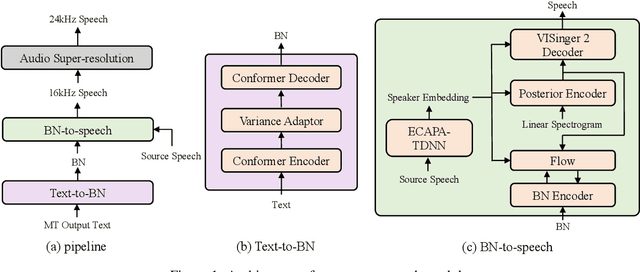
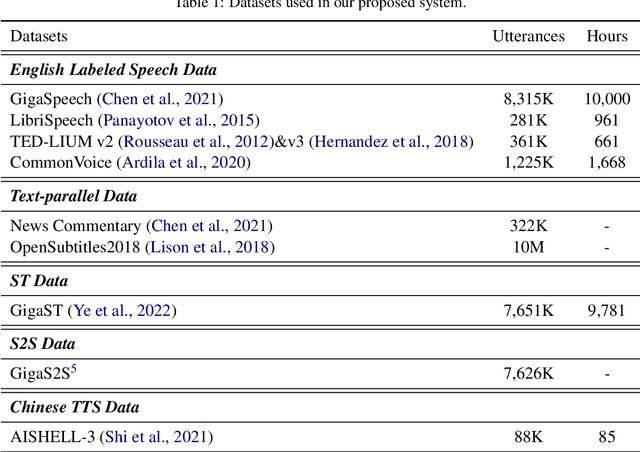
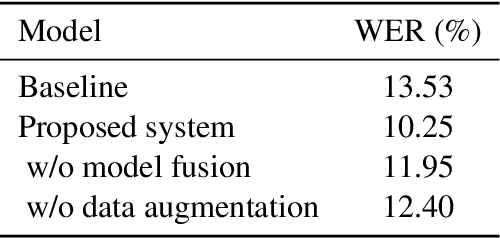
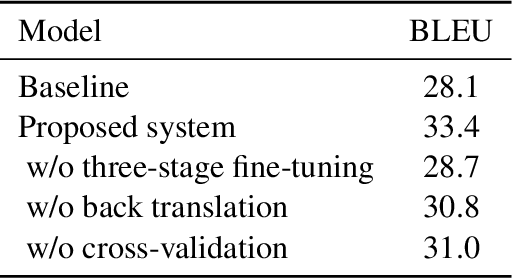
Abstract:This paper describes the NPU-MSXF system for the IWSLT 2023 speech-to-speech translation (S2ST) task which aims to translate from English speech of multi-source to Chinese speech. The system is built in a cascaded manner consisting of automatic speech recognition (ASR), machine translation (MT), and text-to-speech (TTS). We make tremendous efforts to handle the challenging multi-source input. Specifically, to improve the robustness to multi-source speech input, we adopt various data augmentation strategies and a ROVER-based score fusion on multiple ASR model outputs. To better handle the noisy ASR transcripts, we introduce a three-stage fine-tuning strategy to improve translation accuracy. Finally, we build a TTS model with high naturalness and sound quality, which leverages a two-stage framework, using network bottleneck features as a robust intermediate representation for speaker timbre and linguistic content disentanglement. Based on the two-stage framework, pre-trained speaker embedding is leveraged as a condition to transfer the speaker timbre in the source English speech to the translated Chinese speech. Experimental results show that our system has high translation accuracy, speech naturalness, sound quality, and speaker similarity. Moreover, it shows good robustness to multi-source data.
 Add to Chrome
Add to Chrome Add to Firefox
Add to Firefox Add to Edge
Add to Edge